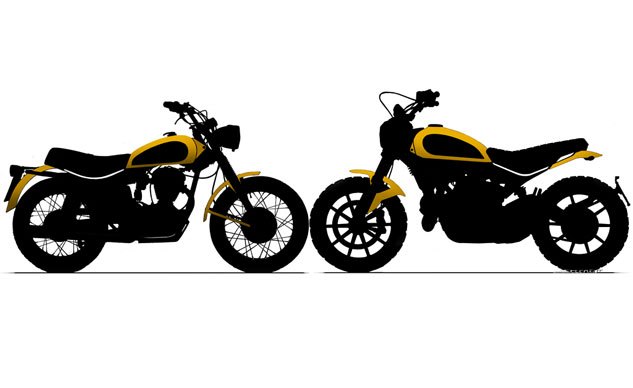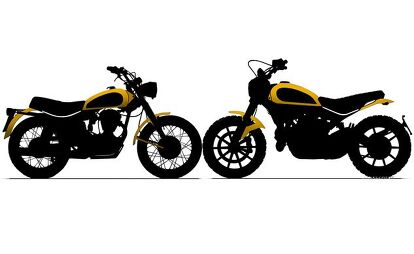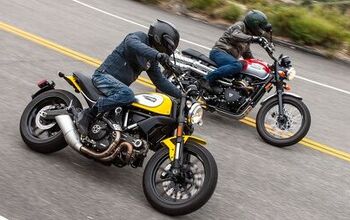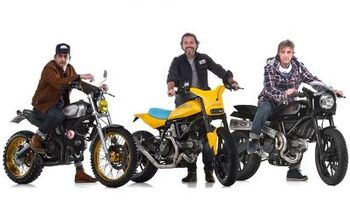Ducati Scrambler Retrospective

Today we’re getting our first crack testing Ducati’s new Scrambler, one of the most talked-about motorcycles of 2015. Some say its all-purpose design perfectly suits their requirements for a retro-themed-but-modern motorcycle, and Ducati tells us initial demand has been huge. Naysayers, however, deride the new Scrambler’s inadequacies for use on dirt trails, asserting that its 800cc V-Twin makes it too heavy when compared to Ducati’s single-cylinder Scramblers from the 1960s and ’70s. So, as we enter a new era of Bologna-built Scramblers, we’re taking a look back at the first-generation models to gain some historical perspective. -Ed.
Fifty years have drifted by since I first laid lustful eyes on a Ducati Scrambler. My friend Hank worked for a Saab dealer who also sold Ducati, Suzuki and Marusho motorcycles. (Making a fortune was obviously not his highest priority.)
Discuss this at our Ducati Scrambler Forum.
Anyway, the Suzuki X6 Hustler upped our heart rate, as did the Ducati Mach 1. Of course, we had to put a few break-in miles on them. But it was the Ducati 250 Scrambler that got the hormones hopping, even though it was no match for the competition-only two-strokes from Spain and Japan. The Duc was more quarter-Sportster than dirt-track racer, but still gobs of fun.
By 1965, its fourth year of production, the Scrambler added a gearbox ratio to create a 5-speed transmission, and still included a competition kit with spare cables, extra front and three rear sprockets, and solid struts to replace the shocks for short-track dirt use. And a hinky muffler for street use if necessary.
But by that time, the level of the game had risen sharply. More riders were forsaking flat track and TT scrambles for motocross. My Bultaco Sherpa 175 Scrambler was swapped for a 250 Pursang. The enduro and dual-purpose markets still grew incrementally, with the efforts of John Penton and others, but motocross ruled.
The weapons from the Japanese Big Four, plus Husqvarna, CZ, Bultaco, Montesa, Ossa and Maico, virtually put true scramblers behind the barn. But street scramblers remained on most manufacturer’s rosters, and the Ducati, in varying 250, 350 and 450cc configurations, would stay in production for 10 years.
The Singles grew steadily less dirt-oriented, and by the ‘70s, Ducati’s racing efforts focused almost exclusively on its V-Twin. The payoff came with the famous Imola road race victory in 1972 – the Superbike era had begun, and the on/off-road market was left to others.
But in another dozen years, the bevel-drive era itself would end, and new owner Cagiva decided to join the sphere of popular Paris/Dakar-style trailies with the Elefant. With 650 and 750cc Ducati Pantah engines housed in box-section perimeter frames, with Ohlins shock and Marzocchi fork, the Elefant was a serious instrument of off-road velocity. It’s on the porky side, but you could ride it to work, or across the country.
One other anomaly in the fettuccine should be mentioned here, which was the brief but glorious appearance in 1993 of the only “modern” Ducati single – the Supermono. A halved Twin, the custom roadracer had a production run of just 67, at $30,000 per. It was beautiful. It was fast. And it was gone. The last one recently posted for sale had an asking price of $150,000.
The veteran Ducatisti have been quite twitterpated over the long-rumored, leaked and teased Scrambler model. Now, with its arrival, both the nit-picking and the compliments have gone up a couple gears. Many of the early skeptics have admitted it looks better than they thought it would. Among the nits: Handlebars are wrong; ugly tank; no skid plate; no high pipe; wrong wheels. Of course, these litanies of lament accompany the release of every new motorcycle and maintain a fairly consistent ratio of the astute to the inane.
Ducati appears to be trading on its heritage with respect here, which is likely to pay off in both sales and good will. The standard roadster market has lately been invigorated, with almost every manufacturer serving that market in various ways. Now that Ducati’s Monster lineup has switched to liquid-cooled engines, it’s good to see its air-cooled V-Twin carry on in the Scrambler.
Having yet to see the new Scrambler in the metal, I can only comment on its stance or aesthetics based on photos. They indicate a simplicity of line and form uncharacteristic of some recent Ducati models, and the design package looks unified and functional. Less functional, at least for off-road trail use, are the mere suggestion of fenders on the Full Throttle and Icon models, which show function following form at some distance. On a moist day, at anything above walking speed, the rider will likely be splattered in road mung front and rear. The Urban Enduro version appears to make the most sense for a street scrambler.
However, like the Monster, the Scrambler will surely serve as an accessory platform for owners and custom builders far and wee. And who can logically argue against an 803cc V-Twin packed with a claimed 75 hp in a 400-lb bike with a rational riding position?
To me, it looks like a nice triple sport – suburban adventure, middleweight touring, commuter scrambler, which is to say, a good all-round motorcycle. I look forward to finding out. And to seeing the first one show up at a half-mile flat-track race.
Rafferty is head cheerleader for Team Geezer, “Sworn to Swerve. Since 1963.” He also swerves as bartender and mascot for the Scar Canyon Scramblers (“Slide ‘Em if you Ride ‘Em”), and is drum major for the Bevelheads, a graying but not quite extinct band of traditional Ducatisti.

More by Tod Rafferty



















































Comments
Join the conversation
great story TR. Does Adolph still make chartreuse and yellow leathers? That look is coming back I think...
Well done Unk. Thanks for the mention and your thoughts on the new Scrambler. I'm afraid I am going to have trot on down to NPR Ducati and plunk down a deposit. I am excited about this bike.